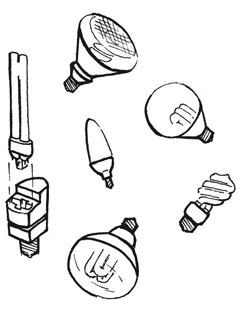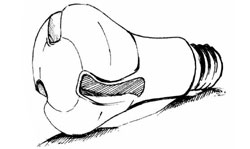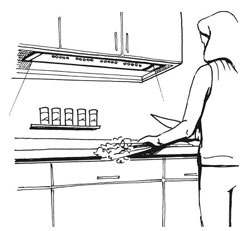LEDs | Incandescent Lighting | Compact Fluorescent Lamps | Linear Fluorescent Lighting | HID Lighting
LEDs
Light-emitting diodes (LEDs) (also called solid state lighting, SSL) technology is evolving rapidly as the newest and most energy-efficient option for a variety of residential lighting applications. An LED is a pea-sized device that uses semi-conducting metal alloys to convert electricity into light. These diodes can be arranged in matrices or clusters offering great design flexibility. Over the past few decades, the development of first blue and now white LEDs has extended their use from simple indicator lights to a wider range of display, task and general lighting applications.
LED bulbs are 30% more efficient than CFLs and 75% more efficient than the best halogen incandescent lamps. A rapidly expanding variety of white LED products are on the market for home use today, including replacement bulbs for most fixture types as well as LED downlight fixtures (recessed cans), desk lamps, under-cabinet lights, outdoor pathway lights, and decorative string lights.
While LED technology is still relatively new, it is definitely ready for prime time. Rapid innovation and significant investment in product development have led to the introduction of dependable and durable products. A wide range of high quality lighting products are available now at affordable prices. As with any new technology, performance and quality varies from product to product. Look for the ENERGY STAR label to identify products that meet high standards for energy efficiency and product performance.
Incandescent Lighting
Until recently, most lighting found in homes was incandescent lighting. In an incandescent lamp, electric current heats up a metal filament in the light bulb, making it glow white-hot and give off light. The problem is that only 10% to 25% of that electricity is actually used to produce light — the rest ends up as heat. During the winter months, incandescent lighting is an expensive form of electric heat; during the summer months, it makes your air conditioner work harder than it has to.
Federal light bulb standards were phased in from 2012 to 2014 (and 2011 to 2013 in California) requiring incandescent lamps to use less energy to produce light equivalent to conventional 40-, 60-, 75- and 100-watt bulbs. In response to the standards, manufacturers have introduced new incandescent bulbs—technically halogen-IR bulbs— that look and perform just like traditional incandscents but use about 30% less energy.
While these new halogen incandescent lamps save energy relative to traditional incandscents, they still use three times more energy than compact fluorescents and LEDs. We strongly recommend replacement of incandescent bulbs with these high-efficiency alternatives. The energy, environmental, and economic benefits of these technologies are discussed in detail below.
Halogen bulbs are really a specialized type of incandescent lamp. A variety of halogen lamp types is available. Halogen is often used where high light quality or precise light focusing is required. Many halogen lamps feature a parabolic aluminized reflector (PAR) to improve light focus. Other small halogen MR-16 lamps are common in track lighting or accent lighting to highlight artwork or architectural features. While halogen lamps are slightly more energy-efficient than standard incandescent lamps, they cannot come close to the energy efficiency of LEDs.




